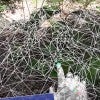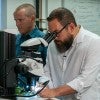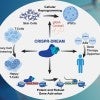
Fenglin Niu named fellow of the American Geophysical Union
Rice University seismologist Fenglin Niu has been elected a fellow of the American Geophysical Union in honor of his leading-edge research in high-resolution seismic imaging.

Fenglin Niu named fellow of the American Geophysical Union
Rice University seismologist Fenglin Niu has been elected a fellow of the American Geophysical Union in honor of his leading-edge research in high-resolution seismic imaging.

Three from Rice elected fellows of the American Physical Society
Rice University faculty members Sibani Lisa Biswal , Kaden Hazzard and Andriy Nevidomskyy have been elected fellows of the American Physical Society.

Rice researcher scans tropical forest with mixed-reality device
Rice University scientists incorporated a Microsoft HoloLens mixed-reality headset with custom-built open-source software to record and store mammal habitat data in the Udzungwa Mountains National Park in Tanzania, showing that there was greater biodiversity where more vegetation was measured.

Decontamination method zaps pollutants from soil
A rapid, high-heat electrothermal soil remediation process developed by Rice scientists and collaborators at the United States Army Engineer Research and Development Center flushes out both organic pollutants and heavy metals in seconds without damaging soil fertility.

Rice University welcomes US Navy research official on campus visit
Rice University welcomed Brett Seidle, deputy assistant secretary of the Navy for research, development, test and engineering, on a campus visit Oct.13.

Rice-engineered material can reconnect severed nerves
Rice neuroengineers designed the first self-rectifying magnetoelectric material and showed it can not only precisely stimulate neurons remotely but also reconnect a broken sciatic nerve in a rat model.

Climate catastrophe produced instantaneous evolutionary change
A unique experiment by Rice University biologists in the wake of 2017’s Hurricane Harvey that revealed species can instantly evolve when they move in response to a climate catastrophe.

Rice, Houston Methodist to unveil state-of-the-art Center for Human Performance Oct. 10
Rice University and Houston Methodist will unveil the Houston Methodist-Rice University Center for Human Performance in an Oct. 10 kickoff event featuring demonstrations of the center’s state-of-the-art capabilities.

DREAM tool for gene therapies uses ‘locally sourced’ components
Rice bioengineers developed a tool that activates silent or insufficiently expressed genes using human-derived building blocks and a CRISPR-based genome-targeting platform.

Robotic cup helps wheelchair users stay hydrated
Rice undergraduate engineering students Thomas Kutcher and Rafe Neathery designed a robotic device that enables people with limited mobility to stay hydrated without caretaker help.

Interdisciplinary Rice team tackles the future of semiconductors
An interdisciplinary team of Rice University scientists has won a $1.9 million National Science Foundation grant for research on materials that could serve as the basis for next-generation energy-efficient computing devices.

Rice alum Louis Brus awarded Nobel Prize in chemistry
Rice alumnus Louis Brus (’65) has been awarded the Nobel Prize in Chemistry alongside Moungi Bawendi and Alexei Ekimov for the “discovery and development of quantum dots.”

Two Rice bioengineers win NIH Director’s New Innovator awards
Rice bioengineers Jerzy Szablowski and Julea Vlassakis received the NIH Director’s New Innovator Award for their respective research projects. Szablowski’s work seeks to develop a noninvasive method of mapping gene expression, while Vlassakis is studying complex, single-cell level processes and interactions in pediatric bone cancer.

NSF backs Rice processor design, chip security research
Rice computer scientists have won two grants from the National Science Foundation to explore new information processing technologies and applications that combine co-designed hardware and software to allow for more effective and efficient data stream analysis using pattern matching.

It's easier to get valuable metals from battery waste if you ‘flash’ it
A battery recycling process developed by Rice scientists can retrieve valuable metals from mixed cathode and anode waste with a yield exceeding 98% in less time than normal using low-concentration acid, reducing both the cost and negative environmental impact.